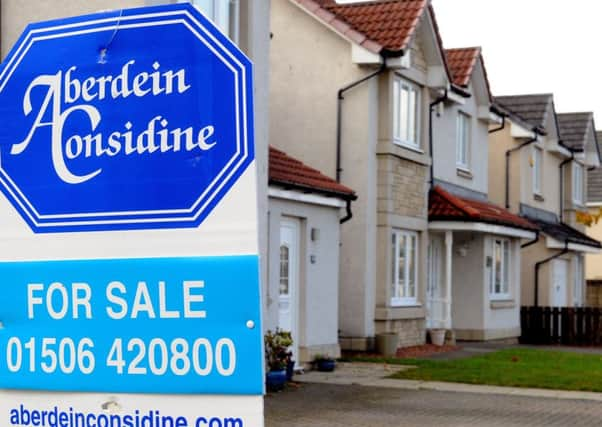Bill Jamieson: Charges shake foundations of property sector


But is it as solid as it seems? There are mixed signals, and it would be wrong to assume that the picture is quite so rosy.
A survey by the Royal Institution of Chartered Surveyors (Rics) released last week found that Scottish house prices continued to rise in January despite flatter demand – but it found that lack of supply was pushing prices higher.
Advertisement
Hide AdAdvertisement
Hide AdThis was due in part to buy-to-let investors moving to purchase property ahead of proposed changes to the Land & Buildings Transactions Tax (L&BTT). From April, people buying second homes and buy-to-let landlords face an additional supplement of 3 per cent of the purchase price.
Sarah Spiers, the Rics director in Scotland, says “Again we are seeing a failure of pick-up in new properties coming onto the Scottish market and, although demand was not as strong this month, housing supply is still lagging.
“However, with buy-to-let investors rushing to get into the market ahead of the L&BTT hike, the near-term pressure on prices is intensifying.”
After this one-off buying bulge there are concerns that some existing landlords will look either to gradually scale back on their portfolios or exit the market altogether as the more penal regime begins to bite.
Meanwhile, Homes for Scotland reminds us that new house building remains 40 per cent down on 2007 levels. HFS chief executive Nicola Barclay is calling on the next Scottish Government to manage a return to pre-recession levels of home building.
This is the background to controversial Scottish Government plans to introduce an extra charge for buy-to-let properties and second homes. Last week the Holyrood parliament’s finance committee backed the new supplement.
The extra levy – following fast on the heels of similar measures for England and Wales announced by Chancellor George Osborne in November – may be seen as just another ruse for Westminster and Holyrood to rake in more money. The rationale is that financial incentives for the buy-to-let sector are too generous, that the sector is soaking up ever greater volumes of mortgage lending, working to reduce the availability of finance and homes for owner-occupier purchase. And here in Scotland, with the administration committed to reducing wealth inequality, it plays to perceptions that buy-to-let developers and second home owners are privileged and can comfortably afford the extra levy.
The combination of L&BTT and the new levy will sharply increase buying costs for many, giving rise to concerns that this may work to impair the housing market and dissuade would-be sellers and buyers.
Advertisement
Hide AdAdvertisement
Hide AdThe committee has called for a number of exemptions to the charge and says it would review the levy after its introduction to ensure it did not have any unintended consequences. That, in view of the potential harmful side-effects, is wholly to be welcomed.
So what might be those adverse effects? Members heard warnings that the supplement could push up rents in the private sector as the additional cost is passed on to tenants. They also heard evidence that it could deter investors, exacerbate property shortages and disadvantage first-time buyers.
A particularly thoughtful contribution to debate on the new levy was submitted by the Council of Mortgage Lenders. It warned that the proposals would create unintended consequences, such as constraining how parents can help their children get on to the housing ladder. Imposing an extra three percentage point L&BTT on purchases at or above £40,000 will, it pointed out, make property purchases up to £145,000, which are currently exempt, subject to L&BTT for the first time.
Its survey research found that nearly four-fifths (79 per cent) of properties bought with a buy-to-let mortgage in the first nine months of 2015 were for sums between £40,000 and £145,000. Thousands of properties each year will now be subject to L&BTT which were exempt before.
But it also has broader concerns: that the increase in transaction costs “can have a detrimental impact on activity levels, market liquidity, labour mobility and how we use our existing housing stock.
“Any measure that seeks to add materially to transaction costs,” it warned, “runs the risk of further undermining market liquidity,” pointing to figures showing that turnover of the Scottish housing stock is already only two-thirds the level of a decade ago.
There are also practical problems. The proposals would require the introduction of a factual definition of main residence, which might be at odds with the treatment for capital gains tax. The main residence test would need to be documented during the conveyancing process, “potentially adding to house purchase costs. This would ultimately represent a self-declaration by the purchaser, which heightens the possibility of confusion, error or deliberate fraud.”
The proposal might also create additional barriers to ownership for first-time buyers whose parents wish to help them purchase their first home, but who are not in a position to act as guarantors or “gift” large sums of money. It appears that where home-owning parents will own any part of their child’s future home, the higher L&BTT will apply in full to that transaction.
Advertisement
Hide AdAdvertisement
Hide AdLevying the tax up front, with the prospect of an eventual rebate as much as 18 months down the line “also appears insensitive both to market realities and individual circumstances.”
What happens, for example, when a house-buying chain breaks down? The problems of sourcing and securing a significant extra L&BTT payment – albeit one that may ultimately be rebated – could be the catalyst for some sales to be cancelled.
It’s certainly encouraging that the Holyrood committee will review how it all works in practice. That is a commendable commitment and one I hope it will fulfil. But by then, considerable damage could have been done. And market confidence would suffer.